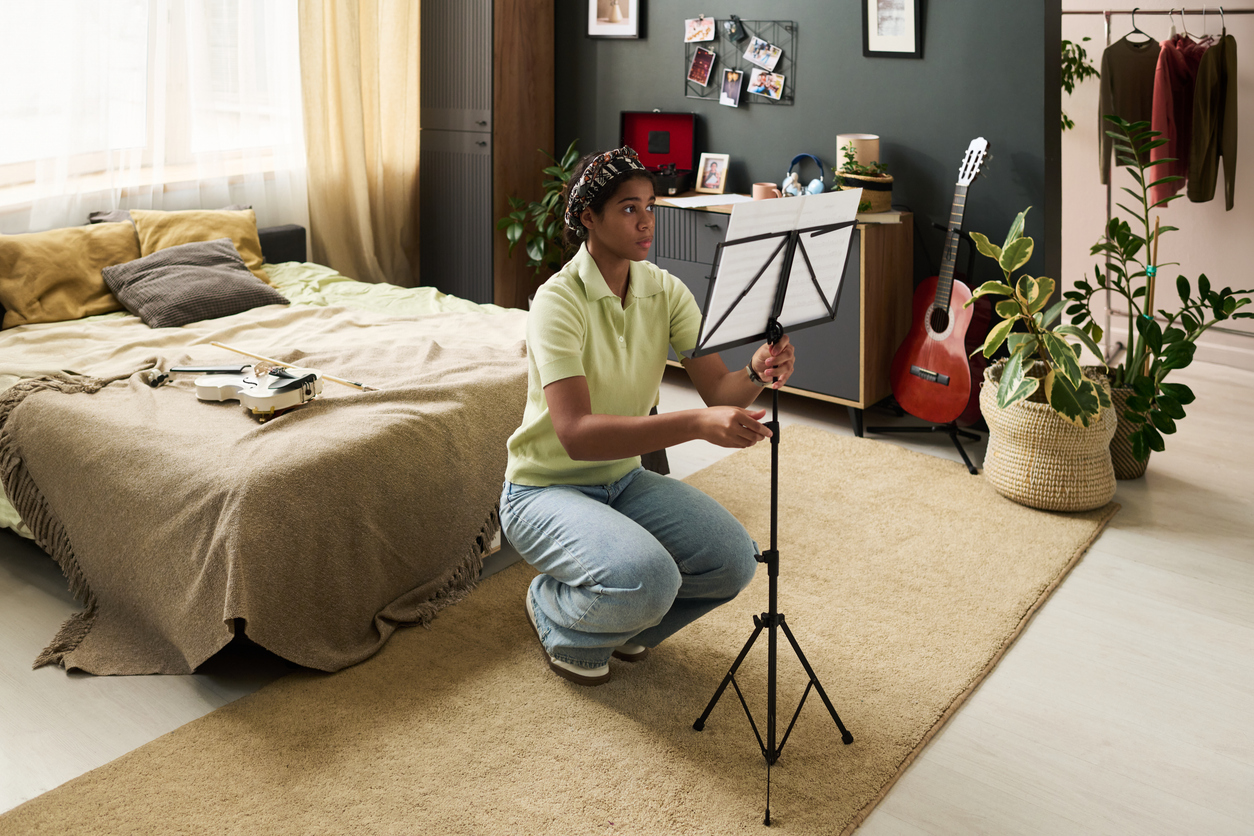Practice might make progress, but greater progress comes when your practice environment supports your goals. For serious violinists ready to invest in their growth, the right instrument practice room can make all the difference. Knowing how to set up a music practice room means understanding how space, acoustics, ambiance, and organization work together to elevate your sound and sharpen your technique.
Whether you’re carving out a corner of your living room or designing a dedicated studio, this guide will help you optimize your setup. We’ll cover everything from how to soundproof a room for music practice to choosing the right gear. Along the way, you’ll discover why a premium bow can unlock even more expressive, refined, and consistent playing in any space.
Start With Acoustics That Work for You
Before you hang a poster on a wall or set your stand on the floor, consider the room’s sound. A good practice room helps your tone bloom, not bounce.
Sound behaves differently depending on the space. Hard surfaces reflect sound waves, creating unwanted echoes or sharpness. To absorb sound and warm up your tone, introduce soft materials into your practice space — rugs, heavy curtains, or even a filled bookshelf. For greater control, consider investing in acoustic panels. Especially consider placing them behind your stand or on parallel walls. This addition can dramatically reduce reflections and improve clarity.
Don’t strive for silence.
The goal for your practice room isn’t silence. The aim is sonic accuracy. You want your practice space to reflect your true tone, helping you to make meaningful refinements that carry into rehearsals and performances.
Soundproof With Neighbors (and Nerves) in Mind
Learning how to soundproof a room for music practice doesn’t require a construction crew. Even small adjustments make a significant impact, especially in apartments, dorms, or shared homes.
Use area rugs and padding to deaden floor vibrations. Add weatherstripping to doors, and consider using a draft stopper at the base of the door. For thin walls, hang quilts, foam, or acoustic panels to help absorb sound and reduce transfer. A thick curtain can serve as a movable sound shield in multi-purpose spaces like the living room.
Practicing at odd hours?
Use a violin practice mute to soften your output while preserving feel and bowing mechanics. If you travel often or live in a particularly noise-sensitive area, a carbon fiber bow like CodaBow, known for consistency and control, lets you focus on form without compensating for unreliable gear.
Organize for Consistency and Flow
A dedicated space should also serve as a basis for good organization. Keep your violin, bow, shoulder rest, and cleaning cloths in one central location. A small cabinet or drawer system can house extras like rosin, tuners, metronomes, and string sets.
For sheet music, use a file box or stand-mounted organizer. If you like to journal or plan your sessions (a good idea for any serious musician), hang a corkboard or whiteboard to track goals and notes. Consistency is key to skill-building, so reduce friction wherever you can. The smoother your setup, the more energy you can invest in actual playing.
Create an Inspiring Ambiance That Invites Practice
Lighting, color, and vibe matter. Your instrument practice room should feel like an invitation, not an obligation. During the day, use natural light to reduce eye strain and enhance focus. In the evening, swap harsh overheads for warm, focused lamps.
Consider what inspires you: framed music posters, quotes, plants, or even a well-placed mirror to monitor posture. Avoid clutter and visual distractions. Instead, cultivate a space that centers your attention and motivates your mind.
When your room supports your musical mood, you’re more likely to show up and stay focused.
Weigh the Pros and Cons of Home vs. Rented Practice Spaces
A home practice room offers unmatched convenience and comfort. You can personalize every detail, play more frequently, and warm up on a moment’s notice. This flexibility leads to more consistent sessions — and more noticeable improvement.
Still, some players benefit from renting rehearsal space, especially when preparing for performances or needing additional room. Studios often have professional acoustics and fewer distractions, but access may be limited to a first-come, first-served basis and require commuting.
If your home setup meets your needs and supports your schedule, there’s no substitute for the consistency and comfort it provides. Home is often the best stage for daily progress.
Use the Right Gear to Hear Real Growth
Even the best practice space won’t do its job if your gear can’t keep up. The bow you use shapes every note you play, especially in a controlled setting where subtle differences become apparent.
CodaBow’s carbon fiber bows are engineered to provide a consistent response across all playing conditions. They offer the refined balance and nuanced control of wood bows ten times their cost without the fragility. Our seven-day in-home trial ensures you’ll get the right bow for you — a bow you can trust to respond faithfully to every shift, stroke, and vibrato.
Combined with a well-designed practice space, the right bow will advance your ability to sharpen your tone and improve your technique with every session.
Build a Space That Serves Your Sound
A great practice room helps you become a better player faster. It removes distractions, supports acoustics, and encourages consistency. Whether you’re tuning up in a small corner or building out a full studio, every thoughtful choice makes your sessions more productive and more enjoyable.
With your space dialed in, your tools matter even more. A premium bow like CodaBow adds clarity, control, and confidence to every note. Refine your space, elevate your sound, and invest in gear that grows with you. Level up your sound and find your CodaBow today.






